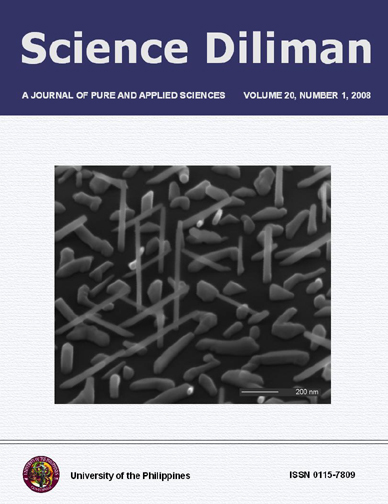Epigallocatechin gallate from <i>Camellia sinensis</i> L. (Kuntze) is a potential quorum sensing inhibitor in <i>Chromobacterium violaceum</i>
Abstract
The problem on the widespread occurrence of antibiotic resistant strains of bacteria calls for novel methods of control of bacterial activity. One of the new viable alternatives to antibiotics is the use of substances that inhibit quorum sensing (QS) – a bacterial communication system that has been known to regulate the expression of virulence genes during infection. In this study, epigallocatechin gallate (EGCG) from green tea, Camellia sinensis L. (Kuntze) was tested for its ability to inhibit QS in a test organism, Chromobacterium violaceum. This microorganism produces a violet-colored substance, violacein, through QS. This study aimed to detect inhibition of QS-regulated violacein production in C. violaceum by EGCG and to determine the dynamics of QS inhibition relative to the concentration of EGCG. The effect of increasing concentration of EGCG on both violacein production and cell density of treated and untreated C. violaceum was determined in a 96-well-microplate format and read at 570nm and 620nm for violacein production and growth, respectively. The results show that addition of EGCG increased the growth of the organism while there is concentration-dependent decrease in the QS-controlled production of violacein. This study thus establishes that EGCG is a potential QS inhibitor and can be further studied and developed for its use as an anti-pathogenic but non-toxic drug.
Published
2008-11-27
Issue
Section
Articles
Keywords
antibiotic resistance, anti-pathogenic, <i>Camellia sinensis</i> L. (Kuntze), <i>Chromobacterium violaceum</i>, epigallocatechin gallate, quorum sensing inhibition
Submission of a manuscript implies: that the work described has not been published before (except in the form of an abstract or as part of a published lecture, review, or thesis); that it is not under consideration for publication elsewhere; that its publication has been approved by all co-authors, if any, as well as by the responsible authorities at the institute where the work has been carried out; that, if and when the manuscript is accepted for publication, the authors agree to the automatic transfer of the copyright to the publisher; that the manuscript will not be published elsewhere in any language without the consent of the copyright holders; that written permission of the copyright holder is obtained by the authors for material used from other copyrighted sources; and that any costs associated with obtaining this permission are the authors’ responsibility.



